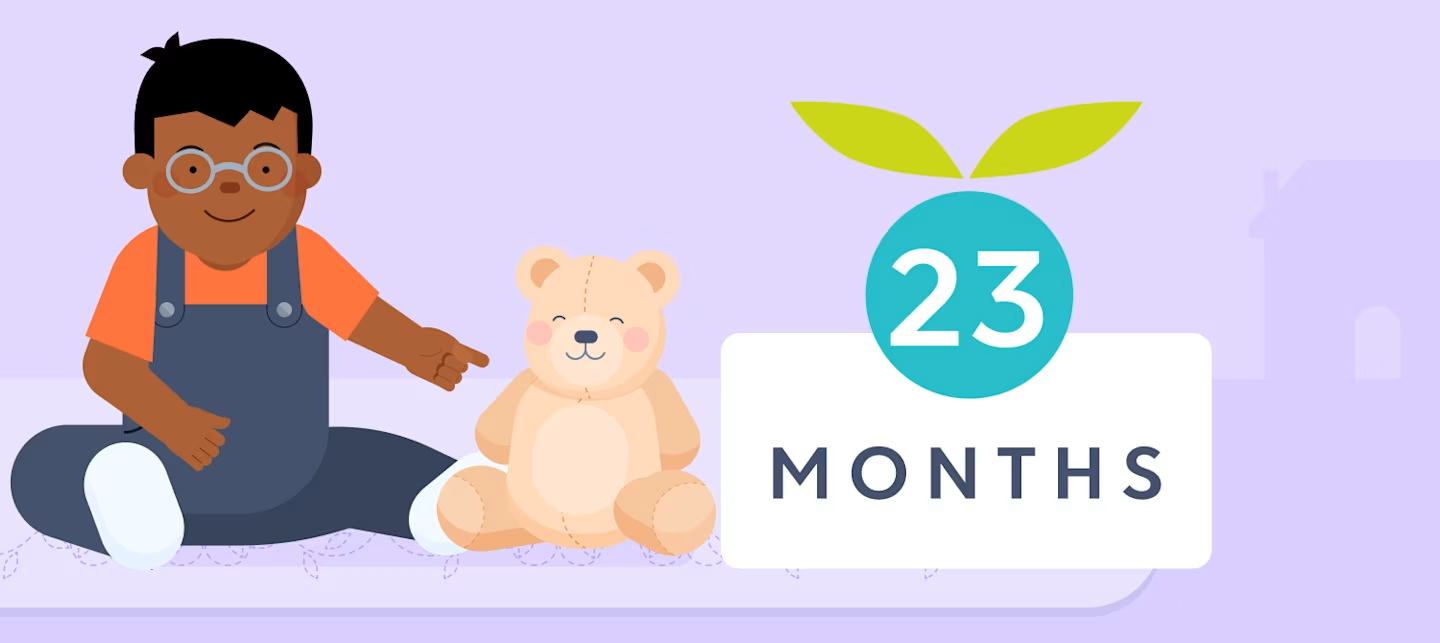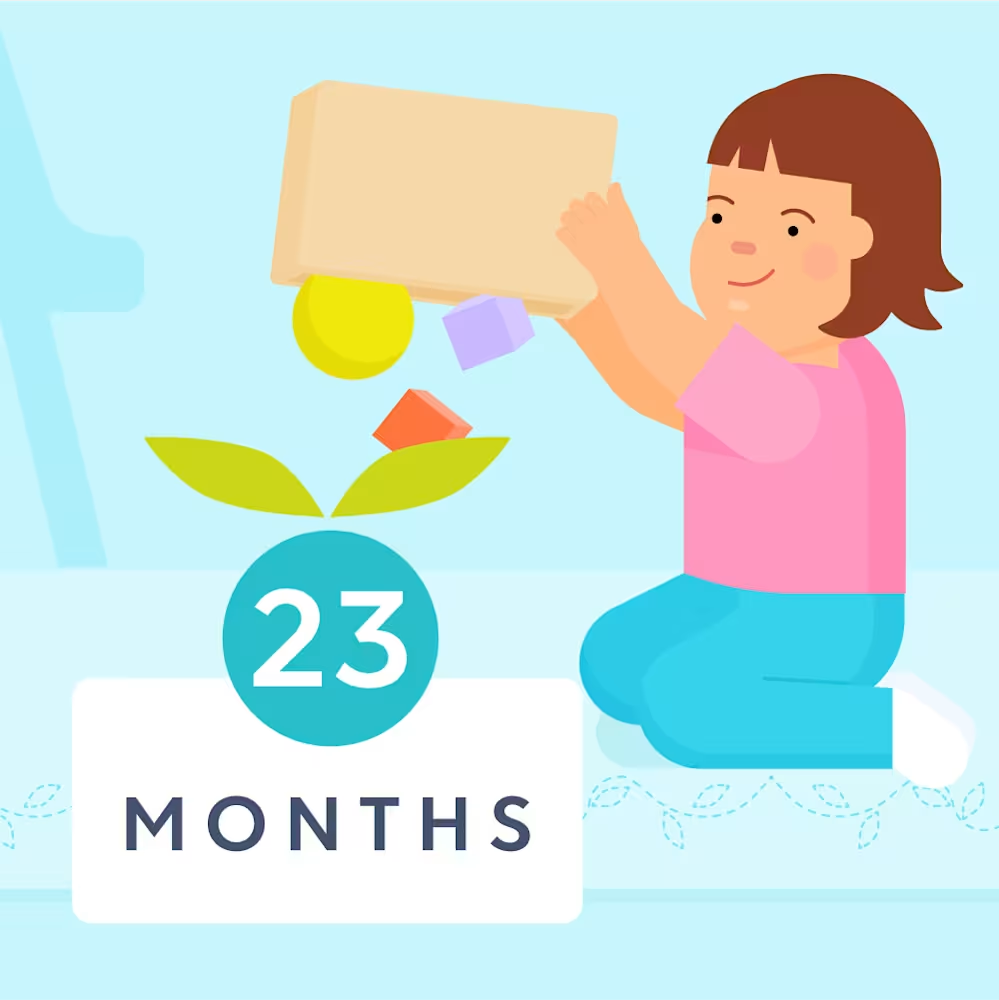23 month old toddler milestones: Development, growth, speech, language
Updated Dec 29, 2025

At 23 months old, the final countdown to your little one's second birthday is on. As you try to slow down time and soak in these last few weeks before you have a 2 year old on your hands, it may already feel like you've already been wrangling one. Those infamous "Terrible Twos" mood swings and meltdowns are common — and developmentally appropriate at this age! In addition to tantrums, other typical milestones at 23 months often include an eagerness to take on independent tasks (especially after they see others model them), ditching climbing for walking up stairs, and speaking more clearly.
In this article, we'll take you through the 23 month old toddler milestones, including speech, language, emotional development, and new motor skills. We'll also give you a handy 23 month old development checklist and useful tips to support your little one's growth.
Editor's note
Not all kids will reach 23 month old milestones at the same time — and that's normal. There's a wide spectrum regarding how fast toddlers grow and develop. While many kids reach these milestones between 23 - 24 months, this isn't always the case. If you have any concerns or questions about your child's development, contact their pediatrician.
Table of Contents
23 month old toddler milestones at a glance
At one year and eleven months, you can expect your toddler to continue to grow and seek more independence as they explore new skills.
Development:
23 month olds are typically making strides in their communication and may say as many as 50 - 100 words by the time they turn 2 []. Some toddlers this age may even be putting 2 - 3 words together to form their first sentences and convey bigger ideas (e.g. "Mama up, go" when they want to be picked up and go outside). As 23 month olds learn how to combine their words to communicate more effectively, they're often also putting new fine motor skills to the test.
At almost 2, toddlers typically absorb everything they hear and see around them — and are eager to try things themselves. This drive for independence combined with the limited abilities of a 23 month old makes for some boundary-testing and limit-pushing behavior. You can also expect turbulent meltdowns when things don't go their way as kiddos continue working on self-control and patience. However, along with mood swings, toddlers at almost 2 may also be starting to develop their social-emotional skills and be in the early stages of exploring key concepts like friendship-building, sharing, cooperation, and manners.
Sleep:
At 23 months, most kiddos need around (about 10 - 12 hours at night and 1.5 - 2.5 hours of day sleep in 1 nap). Most toddlers this age need 5.25 - 5.75 hours of awake time between sleep periods. It's common for 23 month olds to test limits — including when it's time to sleep. Although some little ones may try to push through and skip naps, most children need that daytime sleep until at least 3 years old. Even if your toddler starts to protest, continue offering a nap daily to ensure your kiddo gets the rest they need.
Remember, every child is different, and so are their sleep needs. There's a range of normal when it comes to toddler sleep, and the recommended hours are just a rough estimate — try not to stress about hitting exact numbers. Instead, keep tabs on your little one's mood and energy levels to gauge whether they're getting enough rest.
It’s not uncommon to see abrupt changes in your toddler's sleep patterns around this age, though. If they’re suddenly experiencing disrupted nighttime sleep, difficulty falling asleep, all-out nap strikes during the day, waking very early in the morning, etc., we’d call this a sleep regression. This period of bumpy sleep is common around a child's second birthday and is linked to developmental advances like separation anxiety, milestones such as potty training, and being able to stay awake longer.
While patches of rough sleep are often called the "2 year sleep regression," not every child stops sleeping well right when they turn 2. Instead, sleep regressions can happen at any age. And some kiddos never experience them!
If you'd like personalized sleep guidance for your toddler, especially as you navigate schedule changes and possible nap or bedtime resistance, consider submitting for a sleep plan through. Our step-by-step plans are tailored to your child's needs and your family's goals.
Feeding:
Mealtime at 23 months can feel different from day to day (or even hour to hour). Although toddlers this age tend to eat roughly 5 times a day across, it may not seem like it. That's because kiddos often become picky eaters and have an inconsistent appetite at this age. It's also common (and equally confusing) for your 23 month old to suddenly refuse foods — even favorite foods! This change in hunger and preferences may give you whiplash. Some toddlers may go from being competitive strawberry eaters to completely rejecting them (typically right after you’ve stocked up on them!).
This inconsistency can leave parents feeling like they're strategizing before every meal and analyzing outcomes, trying to figure out if their toddler just wasn't hungry or wasn't into what you served. With this may come mounting pressure to figure out what food to offer your finicky toddler — and then how to get them to eat it.
Take comfort in knowing is developmentally appropriate around this age and can stick around until they're about 4 years old []. Despite these varying hunger levels and picky periods, try not to let that influence what you serve. Continue offering a variety of tastes and textures without worrying about how much they're eating. Your 23 month old may eat a lot during one meal but not much the next. This variation is normal and their intake usually evens out over a week or so.
23 month developmental milestones
Physical development at 23 months
Gross motor milestones
At 23 months, you can expect more coordinated strides to replace your once-wobbly runner []. At this age, toddlers are typically working on new skills like trying to catch a ball (with their arms or body, without losing balance), squatting during play [], and throwing a ball forward. From 19 - 24 months [], you can also expect your toddler to learn to pull toys behind them while walking, climb on low furniture, and stand on their tiptoes. As your toddler's second birthday nears, you can expect them to use their feet to move on a riding toy, kick a ball forward, climb stairs (while holding the railing), and jump in place or forward.
Keep in mind that there's a wide range of normal when it comes to toddler milestones, including gross motor skills. Not all kids will develop them at the same time, so don't be alarmed if your 23 month old isn't a pro at all of these physical milestones just yet. In general, you can expect most kiddos to get the hang of these large movements by their second birthday []. However, check in with your child's healthcare provider if they're not taking independent steps yet [], haven't developed a mature heel-toe walking pattern after several months of walking, are walking exclusively on their toes, or aren't speaking more than 15 words.
Fine motor milestones
23 month olds typically explore the world — and push boundaries — as they develop new fine motor skills. You can expect these little independence seekers to be using their hands and fingers in an attempt to be increasingly self-sufficient. This can look like starting to feed themselves a spoon [] or fork [] and turning pages of a book on their own.
Many toddlers are also exploring cause and effect and learning how things work through actions like flipping light switches on and off, trying different knobs and buttons [], taking toys apart and putting them together again [], and pulling apart connecting blocks []. As toddlers near their second birthday, you can also expect to see them sorting shapes and colors, stacking up to 5 - 6 blocks [], being able to do a 3-piece puzzle, and helping dress themselves []. Their artistic talents may be on display around this age as kiddos can often use pens, markers, or crayons to scribble or make marks on paper [], fold paper (if you show them how), and create shapes with clay.
Speech development
Language skills: At 23 months, toddlers typically use at least 50 words [], with some nearing 100 words as their second birthday approaches []. By 23 months, toddlers can often ask 1 - 2 word questions [], use 2-word phrases, follow 2-step directions, and name familiar objects. You can also expect a 23 month old to imitate new words as they continue learning from (and mimicking []) what they overhear around them. Little ones this age may also understand action words and simple pronouns (e.g. me, you, my). Between 18 - 24 months, little ones typically go through a period of "language explosion []," where they rapidly absorb new words faster than they can say them. During this time, kiddos often can understand more words than they speak and may surprise you with what they comprehend — or repeat — so you may want to watch what you say around them!
Naming things: Toddler this age can usually point to things when you ask them to (like familiar objects in a picture or parts of their body) []. However, around their second birthday, kiddos are also learning to name things, including body parts and animals. The growing ability to point and name things makes reading even more interactive as you can ask questions about things in a book, and they have more ways to answer!
Language "approximations": Between 23 - 24 months, toddlers may know how to say between 50 - 100 words — at least sort of []. You may overhear creative takes on simple words like "aminal" for the animal, "guck" for truck, or "duh" for dog. That's because a 23 month old's pronunciation likely still needs some work. Although it may be harder for people outside your family to understand what your child is saying, these mispronunciations are expected and developmentally normal. Mispronunciations at this age are a good indicator that your toddler is an active listener who is both confident and eager to test what they’re learning.
Gesturing: Your 23 month old may have discovered how easy it is to use their pointer finger to communicate things of interest [] — and the power that comes along with it. Toddlers point to get their point across that they want something and learn to work on patience when they can't always have it right away (or at all). They may also be working on mastering a few other gestures at this age []. Outside of pointing and waving, 23 month olds often learn additional ways of communicating like nodding "yes," shaking their heads "no," and blowing a kiss. Although it may start as mimicking you, these gestures often become independent and intentional ways of expressing themselves as well as interacting with you. Toddlers may also be able to point to a range of familiar people, food, or objects [], 3 - 5 body parts [], and specific objects in a picture when named for them []. As your child’s language comprehension grows, you can also expect to see them using these gestures in pretend play [].
Overgeneralizing: Around 23 months, you may notice your toddler using one word to convey many meanings. Or, taking one word or grammar rule they've learned and broadly applying it. For example, a kiddo may know their pet cat's name is Toby and begin calling all fluffy animals that cross their path "Toby"— from the neighbor's dog to the tiger in their favorite book. Another common example is that toddlers this age may call the adult male in their life "dada" and start using the term to describe other adult men around them — even strangers! But even if your 23 month old uses "mama" for other women or "milky" for other drinks, they do know the difference. It's not that they think other adults are their mom or dad or that all animals are their pets — they’re still learning to sort and label people and objects. Yes, it may feel slightly embarrassing if your kiddo calls a complete stranger "mom" or "dad." But this overgeneralizing phase is common, temporary, and can make for a good laugh!
Social development
Getting territorial: 23 month olds are typically working on sharing and cooperating []. Although they may not understand self-control, patience, or how to gracefully take turns just yet, they often have learned the concept of "mine! []" This self-awareness continues to develop, and so does their possessiveness. This may lead to playdates getting physical — and emotional — as toddlers compete for toys and assert ownership of their items. Although it may feel uncomfortable when your child snatches their favorite truck away from another kiddo, remember this is developmentally appropriate. While little ones at this age may recognize that a toy or snack is theirs, they’re still learning that other people have feelings — and that their actions can affect those around them. This is because toddlers still view themselves as the center of the world []. They aren't doing it to be mean! This period of possessiveness may help toddlers feel like they have some control over their changing world. Also, try to keep in mind this is usually a temporary phase — and a positive one. This territorial stage signifies a milestone in thinking and emotional development. It often means your little one is becoming more self-aware, which is the foundation for important emotions like empathy, self-confidence, and pride!
Pretend play (and noises): As your 23 month old combines their blossoming imagination with independent play and mimicking skills, you may notice some adorable changes to how they play []. Instead of just mimicking sounds or actions they've seen others do, they may take things a step further and use their imagination to incorporate it into make-believe play. For example, they may see you brush your hair each morning or squirm whenever you attempt to tame theirs. As they become more inquisitive and eager for independence, they may grab the brush and try to help you — or do it themselves. But now, they may be pretending to brush their stuffed animal's fur or showing their baby doll how to use the comb. They may also combine sounds with pretend actions, like saying "shhh!" to a baby doll as they return its pacifier or tuck it in with a blanket or saying "vroom!" as they steer their toy car along a pretend road. You may even see things they do in real life incorporated into their imaginative play, like pretending a piece of toy food is hot and blowing on it.
Unpredictable moods: Unpredictable mood swings are normal at this age (and likely will be for a while). At 23 months, toddlers are gaining new skills that foster independence, all while starting to grasp that they’re separate from you — which can feel a bit overwhelming. They’re also still learning how to express what they want and manage big feelings when things don’t go their way. You may be feeling like the “Terrible Twos” have set in already, but keep in mind this is all part of emotional development and won’t last forever.
All of the feelings: Toddlers typically learn about their feelings around this age and what different emotions mean []. Most 23 month olds understand "no" and realize they don't like how that feels or get frustrated when they can't do something themselves. However, they're still working on self-control and understanding what to do when these big feelings hit. Kiddos this age begin to develop empathy [] and may notice when someone is hurt or upset (even if they don't understand how, why, or what that means just yet). They may pause or look sad in response or look to you to see how you react.
23 month milestone checklist
Below is a checklist of milestones toddlers may reach by 23 months. Remember that all toddlers are unique, and there's a spectrum of normal milestones at this age. However, contact your child's healthcare provider if you're concerned about your 23 month old's growth or possible developmental delays.
Milestones to watch for at 23 months:
Uses simple phrases (18 - 24 months) []
Uses two- to four-word sentences
Follows simple instructions
Begins make-believe play
Sorts objects by shapes and colors
Eats with a spoon (19 - 24 months) []
Starts to jump with both feet leaving the ground
Climbs on low furniture
Walks up and down stairs (with support)
Kicks large ball
Runs
Stands on tiptoes
Can pull toys behind them while walking alone
Flips switches on and off, turn knobs, and press buttons
Scribbles
Stacks 5+ or more small blocks or toys
Takes toys apart and puts them back together
Follows two-step directions
Consistently imitates new words
Identifies 3 - 5 body parts when named []
Uses at least 50 words
Understands and uses simple pronouns (me, you, my)
Uses words and gestures during pretend play
Points to objects of interest
Uses both hands equally
Transitions from toe walking to heel-to-toe walking pattern
What are 23 month development red flags?
All toddlers move through milestones at their own speed, but certain delays or behaviors are worth discussing with your pediatrician. Contact your child’s doctor if your 23 month old []:
Doesn’t use pointing to share interest or direct attention
Still isn’t walking on their own
Doesn’t bring or show objects to others
Doesn’t seem to know how to use common household items (like a spoon, brush, or cup)
Rarely imitates what others do
Says fewer than six words or isn’t adding new words to their vocabulary
Doesn’t respond when a caregiver leaves or returns
Has lost abilities they had previously mastered
If you notice any of these signs — or just have a gut feeling that something isn’t right — it’s always a good idea to bring it up with your pediatrician.
3 development tips for 23 months
Tip | Why it helps | How to put it into practice |
|---|---|---|
Stay calm during tantrums | Toddlers swing between “I can do it!” and “Don’t leave me!” Your calm presence helps them ride out those conflicting feelings safely. | Ground yourself first, then offer comfort. Validate their feelings and remind yourself that overwhelm is the culprit. |
Step in before big feelings boil over | Early support helps toddlers regulate before they hit full meltdown mode and teaches them that emotions are manageable. | Watch for early signs of frustration. Pause, offer a break or simple choice, and put their feelings into words to guide them back to center. |
Try simple color-sorting play | Sorting boosts early thinking skills, hand-eye coordination, and color awareness, all through hands-on exploration. | Set out bowls and colorful objects. Do a demo, then let them experiment. Focus on participation and curiosity. |
Find more details below:
Tip #1: Stay cool while they're melting (down)
There's no doubt that mood swings and tantrums at this age can be frustrating for both kiddos and their caregivers alike. And if your toddler emotionally escalates, it can be difficult to remain calm. But instead of ramping up with them, aim to remember there’s a reason for these meltdowns. Toddlers are learning new skills that allow for greater independence while, at the same time, they understand that they're a separate individual from you (which can be scary for them!). Although it can be tough to witness, big emotional swings are normal at this age. Your child is now juggling two strong and conflicting feelings — a growing desire for independence alongside a deep need for the comfort and security they’ve always found in their caregiver.
Hopefully, channeling this sweet sentiment helps bring you calm the next time your toddler goes from an independent explorer to a clingy kiddo who needs extra cuddles and insists on being carried.
Tip #2: Step in early to navigate big emotions
While you can’t prevent every tantrum, stepping in early can make a big difference. Try to catch frustration before it escalates — it’s much easier to redirect or reset when your toddler is still semi-calm. Rather than waiting to see how things play out, help your child take a break, label their emotions, and put their feelings into words. These small, timely interventions support emotional growth and make tough moments a little easier for everyone.
Tip #3: Practice color sorting
Gather a few small containers (bowls or bins) and some safe, colorful objects (think blocks, socks, play food) and show your toddler how to sort the items by color: "Let's put the red ones in this bin, and the blue ones in this bowl," for example. This activity is a great way to build problem-solving skills, strengthen fine motor coordination, and introduce color recognition. Encourage them to try on their own and celebrate their effort, not just their accuracy.
Activities for toddlers at 23 months
1. Keep the conversation going
At 23 months, language can take off in exciting ways — your toddler may start combining 2 – 3 words into simple sentences and eagerly use words they’ve understood for a while. But this burst in communication can also come with bumps, like mispronunciations and short sentences that don’t fully express their thoughts, which can lead to frustration when others don’t understand.
To support their progress, try the “parrot and expand” method: repeat what they say using the correct pronunciation and build on it to model longer, clearer sentences. For example, if they say “Sku day?” you might respond, “Are you asking if today is a school day? Yes, there’s school today! After breakfast, we’ll get dressed and go.” This not only boosts their confidence but also helps strengthen their speech and understanding.
2. Play back-and-forth games
As you work on motor skills like stacking blocks or sorting shapes, you can also build social skills by focusing on how you play — not just what you play with. Try simple back-and-forth games that involve taking turns, like rolling a ball or adding one block at a time to a stack. Model and label turn-taking, praise patience, and gently reinforce boundaries if needed. These playful moments help your toddler practice sharing, self-control, and cooperation in a low-pressure, familiar setting.
Caring for a sick 23 month old
Illness can throw off your toddler’s normal patterns, leaving them more tired, clingy, or with less appetite than usual. These strategies can help make them more comfortable as they recover:
Keep fluids coming: Even if food isn’t appealing, offer water, milk, or other appropriate drinks in small, frequent amounts to help keep your toddler hydrated.
Relieve stuffiness: A runny or blocked nose can make sleep and mealtimes tricky. Saline drops, gentle suction, and a cool-mist humidifier can help clear nasal passages and make breathing easier.
Keep an eye on fever: Reach out to your pediatrician if your child’s fever sticks around for more than 24 hours or rises above 104°F (40°C) more than once []. With a doctor’s approval, you can use infant or children’s Tylenol or Motrin. Skip cough and cold medicines, as they aren’t safe for toddlers.
Expect sleep changes: Being sick can lead to more naps, restless nights, or skipped sleep altogether. Let your toddler’s needs guide you, and return to your normal routine once they’re better.
Offer comfort: Some toddlers want extra closeness when they’re sick, while others prefer space. Follow their lead and offer the reassurance they need. And remember to care for yourself too — leaning on a partner, family, or friends can help lighten the load.
When to seek help
If your child has a fever for more than 24 hours or it reaches above 104°F (40°C), call their doctor right away. These can be signs of a more serious infection or illness and it's best to rule out anything that needs medical attention.
In general, if something feels off or you’re worried about how your child looks or acts, it’s safest to check in with their doctor. And if you already talked to them but symptoms appear worse, that’s a good time to check back in too.
Takeaway
23 month olds are typically developing physical skills like walking up stairs (with support), running with more coordination, and kicking a large ball. Around 23 months, toddlers often start jumping with both feet, leaving the ground, squatting during play, engaging in pretend play, throwing a ball forward, and trying to catch it (with their arms or body).
Toddlers may be chatting more than ever with 50 -100 words [] in their vocabulary (although they may mispronounce some of them!).
23 month olds are commonly picky eaters with inconsistent appetites. Despite these fickle eating habits, 23 month olds typically need three meals and two snacks per day (whether they eat them or not). Keep in mind that these bouts of picky eating are expected and usually normal at this age. However, bring up concerns about your child's eating habits with their healthcare provider.
There's a wide range of what's considered "normal" when it comes to 23 month milestones. As toddlers finish their second year, they won't all be on the same developmental timeline, and that's OK. Not all kiddos will have mastered all of these skills just yet, so don't worry if yours hasn't. However, always listen to your gut and contact your child's healthcare provider if you notice any concerns, developmental red flags, or delays.
23 month developmental milestones FAQ
Share article:
Note: The content on this site is for informational purposes only and should not replace medical advice from your doctor, pediatrician, or medical professional. If you have questions or concerns, you should contact a medical professional.
12 Sources
Table of Contents
Share article:





